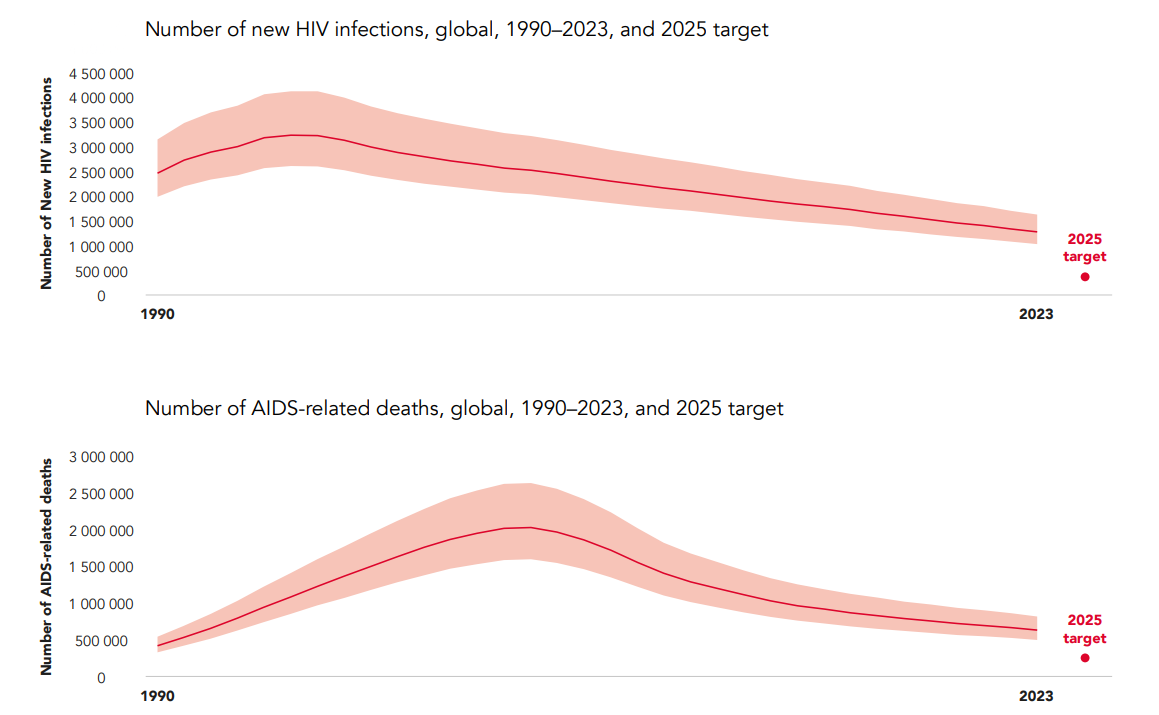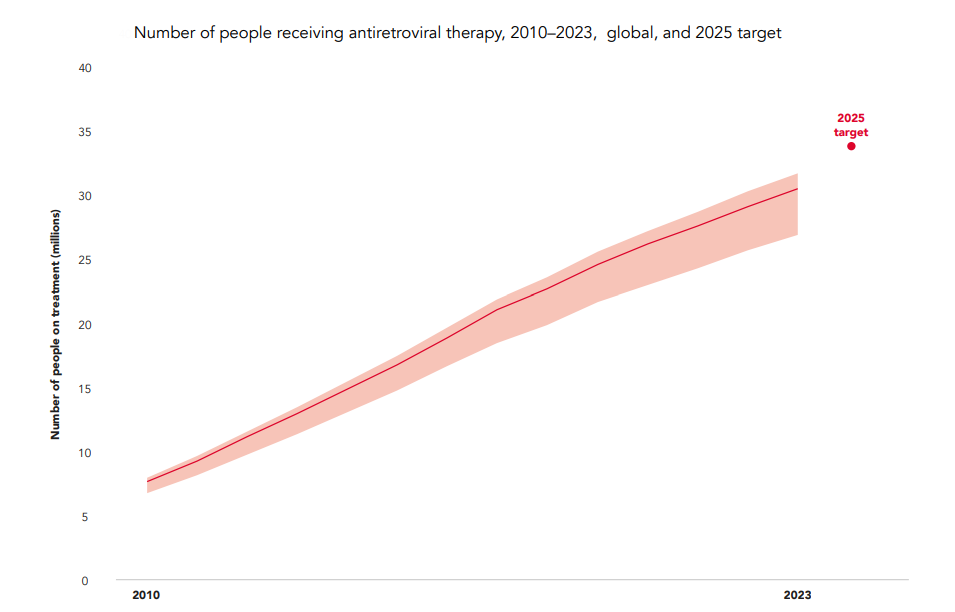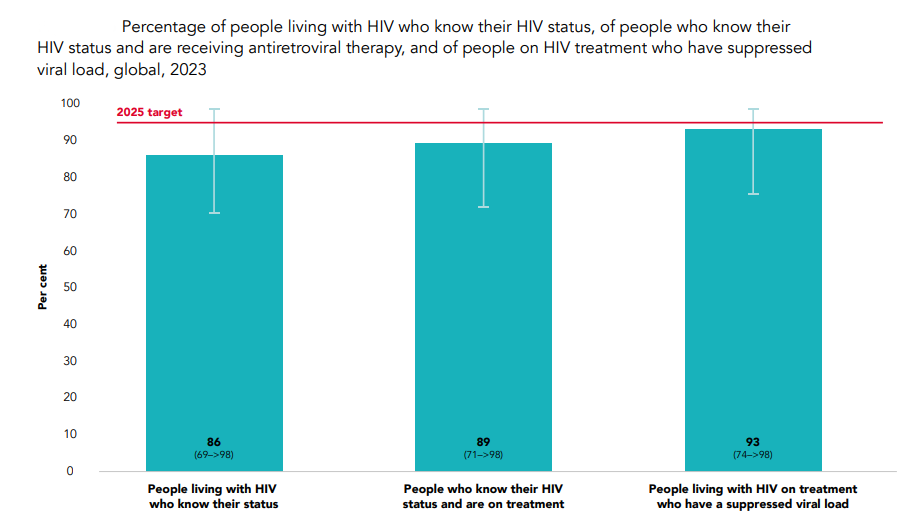Science & Technology
UNAIDS Global AIDS Update
- 24 Jul 2024
- 15 min read
For Prelims: Acquired Immunodeficiency Syndrome (AIDS), Human Immunodeficiency Virus (HIV), Antiretroviral Therapy (ART), UNAIDS, Global AIDS Update
For Mains: Challenges Related to AIDS, Steps Needed to Eliminate AIDS
Why in News?
Recently, the 2024 UNAIDS Global AIDS Update, titled "The Urgency of Now: AIDS at a Crossroads", presented a critical overview of the current state of the HIV/AIDS epidemic and the global response to it.
What are the Key Highlights of the Reports?
- About:
- The report underscores the potential to end AIDS as a public health threat by 2030, emphasising the necessity of addressing inequalities, increasing access to prevention and treatment, and ensuring sustainable resources.
- Progress and Challenges:
- Reduction in New HIV Infections and AIDS-Related Deaths:
- There has been a 39% reduction in new HIV infections globally since 2010, with sub-Saharan Africa achieving the steepest decline (56%).
- In 2023, fewer people acquired HIV than at any point since the late 1980s, and almost 31 million people were receiving antiretroviral therapy (ART).
- AIDS-related deaths have decreased to their lowest level since the peak in 2004, largely due to increased access to ART.
- Regional Disparities:
- While sub-Saharan Africa has seen significant progress, regions such as Eastern Europe, Central Asia, Latin America, and the Middle East and North Africa have experienced rising numbers of new HIV infections.
- For the first time, more new HIV infections occurred outside sub-Saharan Africa than within it.
- Key Affected Groups:
- Key populations, including sex workers, men who have sex with men, people who inject drugs, transgender people, and people in prisons, continue to face high risks of HIV infection due to inadequate prevention programs and persistent stigma and discrimination.
- Community-led interventions are critical but often underfunded and unrecognized.
- Prevention and Treatment Gaps:
- HIV prevention efforts are falling short, with notable deficiencies in access to services like pre-exposure prophylaxis (PrEP) and harm reduction for people who inject drugs.
- About 9.3 million people living with HIV are not receiving ART, with children and adolescents particularly affected.
- Reduction in New HIV Infections and AIDS-Related Deaths:
UNAIDS
- UNAIDS is a model for United Nations reform and is the only cosponsored Joint Programme in the United Nations system.
- It draws on the experience and expertise of 11 United Nations system Cosponsors and is the only United Nations entity with civil society represented on its governing body.
- UNAIDS is leading the global effort to end AIDS as a public health threat by 2030 as part of the Sustainable Development Goals.
 What is HIV/AIDS?
What is HIV/AIDS?
- About:
- HIV/AIDS is a viral infection that attacks the immune system, specifically the CD4 cells (T cells), which help the immune system fight off infections.
- Left untreated, HIV reduces the number of CD4 cells (T cells) in the body, making the person more likely to get infections or infection-related cancers.
- AIDS is the final stage of HIV infection when the immune system is severely damaged and can no longer fight off infections.
- Causes of HIV/AIDS:
- HIV infection is caused by the human immunodeficiency virus (HIV). The virus is transmitted through contact with infected bodily fluids, such as blood, semen, vaginal fluids, rectal fluids, and breast milk.
- It can be spread through sexual contact, sharing needles or syringes, from mother to child during childbirth or breastfeeding, and rarely, through blood transfusions or organ transplants.
- Symptoms of HIV/AIDS:
- Clinical Latent Infection:
- HIV is still active but reproduces at very low levels. People may not have any symptoms or only mild ones.
- Acute HIV Infection:
- Symptoms can resemble those of the flu, including fever, swollen lymph nodes, sore throat, rash, muscle and joint aches, and headache.
- AIDS:
- The symptoms of AIDS are severe and include rapid weight loss, recurring fever or profuse night sweats, extreme and unexplained tiredness etc.
- Clinical Latent Infection:
- Diagnosis of HIV/AIDS:
- HIV antibody/antigen tests: These tests detect antibodies or antigens produced by the virus and are usually done on blood or oral fluid.
- Nucleic acid tests (NATs): These tests look for the virus itself and can detect HIV infection earlier than antibody tests.
- Treatment and Management:
- Antiretroviral therapy (ART): ART involves taking a combination of HIV medicines every day. ART can't cure HIV, but it can control the virus, allowing people with HIV to live longer, healthier lives and reducing the risk of transmitting the virus to others.
- Pre-exposure prophylaxis (PrEP): PrEP is a daily pill for people who don't have HIV but are at risk of getting it. When taken consistently, PrEP can reduce the risk of HIV infection.
- A revolutionary HIV drug that reduces the need for a daily cocktail of drugs to half a dozen injections a year has recently been approved in the UK.
India's Efforts to Prevent HIV
- HIV and AIDS (Prevention and Control) Act, 2017
- Access to Antiretroviral Therapy (ART)
- Memorandum of Understanding (MoU): The Ministry of Health and Family Welfare signed a MoU with the Ministry of Social Justice and Empowerment in 2019 for enhanced HIV/AIDS outreach and to reduce the incidence of social stigma and discrimination against victims of drug abuse and Children and People Living with HIV/AIDS.
- Project Sunrise:
- Project Sunrise was launched by the Ministry of Health and Family Welfare in 2016, to tackle the rising HIV prevalence in north-eastern states in India, especially among people injecting drugs.
- Targets: India sought to leverage the targeted interventions to achieve UNAIDS's 90-90-90 targets (90% of HIV-infected individuals diagnosed, 90% of those diagnosed to be on anti-retroviral therapy (ART), and 90% of people on ART to achieve sustained virologic suppression), and end AIDS by 2030
International Initiatives
- Joint United Nations Programme on HIV/AIDS:
- It is leading the global effort to end AIDS as a public health threat by 2030 as part of the Sustainable Development Goals. It was started in 1996.
- UNAIDS has a vision of zero new HIV infections, zero discrimination and zero AIDS-related deaths, and a principle of leaving no one behind.
- The UN Political Declaration on Ending AIDS was adopted in 2016 which seeks to end AIDS as a public health threat by 2030.
- The World Health Organization's (WHO) “Treat All” guidance of September 2015, recommended that all individuals be treated as soon as possible after HIV infection and diagnosis.
- In addition, because the reduction in HIV viral load to undetectable levels eliminates the risk of onward transmission, the Treat All approach has the potential to provide the population health benefit of reducing HIV incidence.
- Global AIDS Strategy 2021-2026 - End Inequalities. End AIDS. is a bold new approach to using an inequalities lens to close the gaps that are preventing progress towards ending AIDS.
What are the Key Suggestions From the Report?
- Accelerating HIV Prevention:
- The report emphasises the need to expand access to HIV prevention services, particularly for key populations including sex workers, men who have sex with men, people who inject drugs, transgender people, and people in prisons.
- Reinstate and fund condom programs for safe sex, especially in regions where their use has declined.
- Scale up the availability and use of PrEP, aiming to reach the global target of 21.2 million people using PrEP by 2025.
- Enhancing Treatment and Care:
- Ensure that 95% of people living with HIV are on ART by 2025. Currently, only 77% of people living with HIV are receiving ART.
- Improve the diagnosis and treatment of children with HIV. Only 48% of children living with HIV are receiving ART, compared to 78% of adults.
- Integrate HIV services with broader health services to improve outcomes and address comorbidities such as tuberculosis, hepatitis, and non-communicable diseases.
- Addressing Inequalities and Stigma:
- Remove harmful laws that criminalise HIV transmission, exposure, and non-disclosure, as well as those targeting key populations. Currently, punitive laws are prevalent in most countries.
- Implement programs to reduce stigma and discrimination in health care and community settings. Ensure legal protection and support for people living with HIV and key populations.
- Community-Led Responses:
- Strengthen the role of community-led organisations in delivering HIV services.
- The goal is for these organizations to deliver 30% of testing and treatment services and 80% of HIV prevention services for high-risk populations.
- Strengthen the role of community-led organisations in delivering HIV services.
- Sustainable Financing:
- Address the significant shortfall in funding for HIV programs. An estimated additional USD 9.5 billion is needed by 2025 to meet the targets.
- Explore new funding sources and mechanisms to sustain the HIV response, especially in low- and middle-income countries.
|
Drishti Mains Question: Discuss the major challenges in eliminating AIDS in developing countries like India. Suggest measures to address these challenges. |
UPSC Civil Services Examination, Previous Year Question (PYQ)
Prelims:
Q. Consider the following statements: (2021)
- Adenoviruses have single-stranded DNA genomes whereas retroviruses have double-stranded DNA genomes.
- Common cold is sometimes caused by an adenovirus whereas AIDS is caused by a retrovirus.
Which of the statements given above is/are correct?
(a) 1 only
(b) 2 only
(c) Both 1 and 2
(d) Neither 1 nor 2
Ans: (b)
Q. Which of the following diseases can be transmitted from one person to another through tattooing? (2013)
- Chikungunya
- Hepatitis B
- HIV-AIDS
Select the correct answer using the codes given below:
(a) 1 only
(b) 2 and 3 only
(c) 1 and 3 only
(d) 1, 2 and 3
Ans: (b)
Q. With regard to the transmission of the Human Immunodeficiency Virus, which one of the following statements is not correct? (2010)
(a) The chances of transmission from female to male are twice as likely as from male to female
(b) The chances of transmission are more if a person suffers from other sexually transmitted infections
(c) An infected mother can transmit the infection to her baby during pregnancy, at childbirth and by breast feeding
(d) The risk of contracting infection from transfusion of infected blood is much higher than an exposure to contaminated needle
Ans: (a)
Q. Consider the following statements: (2010)
- Hepatitis B is several times more infectious than HIV/AIDS
- Hepatitis B can cause liver cancer
Which of the statements given above is/are correct?
(a) 1 only
(b) 2 only
(c) Both 1 and 2
(d) Neither 1 nor 2
Ans: (c)
Mains:
Q. In order to enhance the prospects of social development,sound and adequate health care policies are needed particularly in the fields of geriatric and maternal health care. Discuss. (2020)






